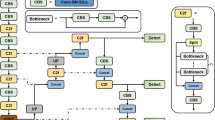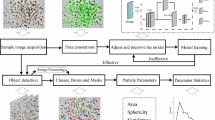Abstract
There are several methods for measuring the particle size distribution of the comminuted minerals, but the most used in situ analysis methods are sieving and microscopic analysis due to the particle size characteristics. This paper presents the improved method of the microscopic image analysis to improve the accuracy estimating the particle size distribution of comminuted minerals. The image processing methods we used are microscopic image stitching, individual particle segmentation with watershed and deep learning and individual particle weight estimation with shape factor. We experimented with three samples, namely ferruginous quartzite, coal and magnetite, for estimation of the particle size distribution, and confirmed to improve the accuracy estimation through comparison with sieving test.


















Similar content being viewed by others
References
Bernhardt C (1994) Particle size analysis: classification and sedimentation methods. New Delhi. Thomson Press Ltd
Fleming BW, Thum AB (1978) The settling tube-a hydraulic method for grain size analysis of sands. Kieler Meeresforschungen 4(1):82–95
Gibbs RJ (1974) A settling tube system for sand-size analysis. J Sediment Res 44(2):583–588
Poole DM (1957) Size analysis of sand by a sedimentation technique. J Sediment Res 27(4):460–468
Beuselinck L (1998) Grain-size analysis by laser diffractometry: comparison with the sieve-pipette method. CATENA 32(3–4):193–208
Konert M, Vandenberghe J (1997) Comparison of laser grain size analysis with pipette and sieve analysis: a solution for the underestimation of the clay fraction. Sedimentology 44(3):523–535
Zhang ZL, Yang JG, Ding LH, Zhao YM (2012) An improved estimation of coal particle mass using image analysis. Powder Technol 229:178–184
Kursun I (2009) Particle size and shape characteristics of kemerburgaz quartz sands obtained by sieving laser diffraction and digital image processing methods. Miner Process Extr Metall Rev 30(4):346–360
Coster M, Chermant JL (2001) Image analysis and mathematical morphology for civil engineering materials. Cem Concr Compos 23(2–3):133–151
Marinoni N, Pavese A, Foi M, Trombino L (2005) Characterisation of mortar morphology in thin sections by digital image processing. Cem Concr Res 35(8):1613–1619
Wang WX (2006) Size and shape measure of particles by image analysis. In: IWCIA 2006: combinatorial image analysis pp 253–262
Al-Rousan T, Masad E, Tutumluer E, Pan T (2007) Evaluation of image analysis techniques for quantifying aggregate shape characteristics. Constr Build Mater 21(5):978–990
Kumara Janaka J, Hayano K, Ogiwara K (2012) Image analysis techniques on evaluation of particle size distribution of gravel. Int J GEOMATE 3(1):290–297
Podczeck F (1997) A shape factor to assess the shape of particles using image analysis. Powder Technol 93:47–53
Olson E (2011) Particle shape factors and their use in image analysis—part 1: theory. J GXP Compliance 15(3):85–96
Stanley-Wood NG, Lines RW (2007) Particle size analysis. Royal Society of Chemistry, London
Lowe DG (2004) Distinctive image features from scale-invariant keypoints. Int J Comput Vision 60(2):91–110
Bay H, Ess A, Tuytelaars T, Gool LV (2008) Speeded-up robust features (SURF). Comput Vis Image Underst 110(3):346–359
Ro SH, Kim SH (2021) An image stitching algorithm for the mineralogical analysis. Miner Eng 169:106968
Beare R (2005) Efficient implementation of the locally constrained watershed transform and seeded region growing. mathematical morphology: 40 Years On: pp 217–226
Landeen T and Gunther J (2018) Deep learning based image overlap detection. https://digitalcommons.usu.edu/cgi/viewcontent.cgi?article=1510&context=spacegrant, Google scholar
Sun HQ, Luo YJ (2009) Adaptive watershed segmentation of binary particle image. J Microsc 233:326–330
Teng L, Li H, Karim S (2019) DMCNN: a deep multiscale convolutional neural network model for medical image segmentation. J Healthc Eng 1–10:8597606
Zhou Y, Gao Q, Wang Y, Zhou K (2014) Systematical improvements of trace gold field rapid determination method. Geophys Geochem Explor 3:539–543
Acknowledgments
This research did not receive any specific grant from funding agencies in the public, commercial, or not-for-profit sectors.
Author information
Authors and Affiliations
Corresponding author
Ethics declarations
Conflict of interest
The authors declare that they have no conflict of interest.
Additional information
Publisher's Note
Springer Nature remains neutral with regard to jurisdictional claims in published maps and institutional affiliations.
Rights and permissions
Springer Nature or its licensor (e.g. a society or other partner) holds exclusive rights to this article under a publishing agreement with the author(s) or other rightsholder(s); author self-archiving of the accepted manuscript version of this article is solely governed by the terms of such publishing agreement and applicable law.
About this article
Cite this article
Ro, S., Jon, J. & Ryu, K. A method for improving the estimation accuracy of the particle size distribution of the minerals using image analysis. Comp. Part. Mech. 10, 929–941 (2023). https://doi.org/10.1007/s40571-022-00538-x
Received:
Revised:
Accepted:
Published:
Issue Date:
DOI: https://doi.org/10.1007/s40571-022-00538-x




